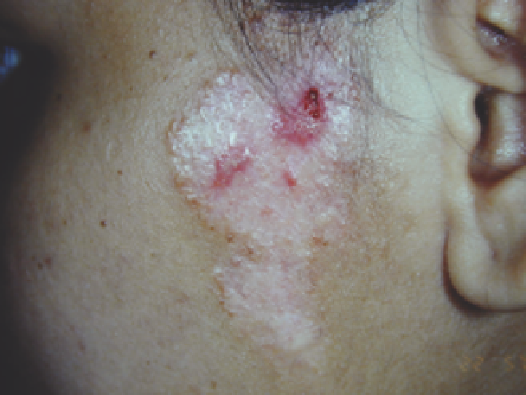Biomedical Engineering Reference
In-Depth Information
a spectrum of wavelengths that can be selectively absorbed
by oxyhemoglobin. These include argon laser (AL) (488
and 514 nm), copper vapor laser (CVL) (511 and 578 nm),
potassium titanyl phosphate (KTP) laser (532 nm), variable
pulse width frequency-doubled neodymium-doped:yttrium-
aluminum-garnet (Nd:YAG) 532 nm (VP 532) laser, tunable
dye lasers (577, 585, 595, and 600 nm), long-pulsed (LP)
Nd:YAG laser (1064 nm) and IPL system (>515 nm). In Asian
skin, melanin competes strongly for laser light absorption.
Melanin has strong absorption in the 350-1200 nm wave-
length regions, being strongest in the UV range and decreas-
ing exponentially through visible and into near-infrared
wavelengths. In dark-skinned individuals the abundance of
this chromophore in relation to oxyhemoglobin in cutaneous
blood vessels acts as a total barrier to light from microvascular
lasers and IPL system (18). Epidermal pigmentation is per-
haps the most fundamental limitation, because it diminishes
laser light reaching the dermis and causes unwanted thermal
damage to the epidermis (19-21).
Figure 13.1
Atrophic scar and persistent hypopigmentation at 6 months after
two, 585-nm pulsed dye laser treatments at average fl uence of 7 J/cm
2
using a
7-mm spot size without epidermal cooling device.
Port-Wine Stain
A study on the treatment of port-wine stains (PWS) using a
585-nm fl ashlamp-pumped pulsed dye laser (PDL; SPTL-1;
Candela Laser Corp., Wayland, Massachusetts, USA) has
shown that patients with skin types IV and V responded to
treatment more slowly and required more treatment sessions
to reach the same degree of clearing than patients with skin
types I-III (22). In addition, patients with skin types IV-V had
a higher overall percentage of none to poor, and slight respond-
ers than those of the skin types I-III group (30% vs. 16%). In
contrast, when using the 585-nm PDL to treat facial telangiec-
tasia, the same investigators found that skin type had no mea-
surable infl uence on treatment response.
The infl uence of preoperative skin pigmentation on adverse
effects following treatment with CVL, AL, and 585-nm
fl ashlamp-pumped PDL has been well documented (23-25).
Studies have shown that the risk of inducing clinically visible
pigmentary alterations and textural changes increases with
higher preoperative skin pigmentation, and with the applica-
tion of increasing laser energy. However, pigmentary alteration
(hyper- and hypopigmentation) was found to occur at a sig-
nifi cantly lower intensity level than scarring (texture change,
atrophy, hypertrophy, and skin shrinkage). Darkly pigmented
individuals obtained more severe wounding than fair-skinned
subjects from AL and CVL treatment (26). In addition, the
immediate histological outcome after these laser treatments
has been found to depend on the pretreatment pigmentation
content (20,21).
Side effects after laser treatment of vascular malformations
are theoretically due to three different mechanisms, all of
which result in nonspecifi c energy deposition: (
i
) direct and
competitive absorption by epidermal melanin; (
ii
) thermal
diffusion away from the absorbing chromophores, primarily
melanin and hemoglobin; and (
iii
) scattering effects that indi-
rectly increase epidermal and dermal nonspecifi c injury
(18,25).
Asian patients with PWS are less responsive to PDL and VP
532 laser treatment with higher risk for adverse effects, such
as vesiculation and pigmentary alterations (Fig. 13.1). How-
ever, dark-skinned patients should not be excluded from laser
(27-30) and IPL (31,32) therapies, provided that treatment
expectation and risks are fully discussed. A retrospective study
evaluating the results of a VP 532 laser, coupled with a cooling
tip in the treatment of PWS in Chinese patients, found that
this laser was only partially effective (27). Potential limita-
tions of 532-nm light sources are that (although selective
absorption of light by hemoglobin is equal to 585 nm) the
shorter wavelength penetrates less deeply and is, therefore,
less effective for deeper targets. Furthermore, melanin absorp-
tion is increased, making this wavelength suboptimal for
Asian and darker skin types and also increasing the risk of
hypopigmentation.
The development of a longer wavelength (595 nm), adjust-
able pulse width (0.45-40 ms) with a cooling device, is an alter-
native vascular-specifi c laser for dark-skinned patients. The
laser operating at a longer wavelength of 595 nm is less absorbed
by epidermal melanin. Therefore, it causes less nonspecifi c
injury to the pigmented epidermis compared with that of the
585-nm PDL. The adjustable pulse width and longer wave-
length also enables the pulsed light to target larger caliber and
more deeply situated vessels in the skin. However, the conven-
tional 585-nm PDL has demonstrated a signifi cantly greater
clearance rate than it did at the same setting of 595-nm PDL. In
addition, the former also caused higher incidence of adverse
effects, including pain, postoperative purpura, crusting, and
transient hyperpigmentation (29,33,34). The higher incidence
of complications is more likely due to the slightly higher
absorption by epidermal melanin at the 585-nm wavelength.
The epidermal cooling device has been demonstrated to
reduce adverse complications and improve the clinical effi cacy
of PDL for the treatment of PWS in Chinese patients (35,36).
The use of cryogen spray cooling improves clinical effi cacy, and
a higher fl uence can be used without an increase in complica-
tions such as permanent scarring or dyspigmentation. As a
result, PDLs equipped with an epidermal cooling device of
some types are considered to be the optimal lasers for treatment
of PWS in Asians (Fig. 13.2). IPL treatment has been proved to
be effective in PWS in Chinese patients (31,32). The clearing
rate was reported to be better than that of PDL without cooling
with fewer long-term complications. However, the authors
















